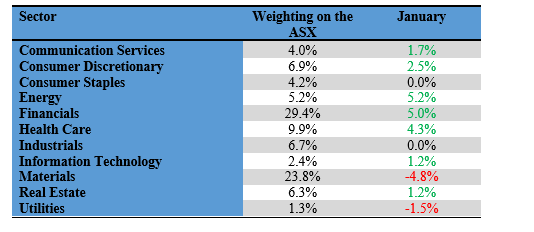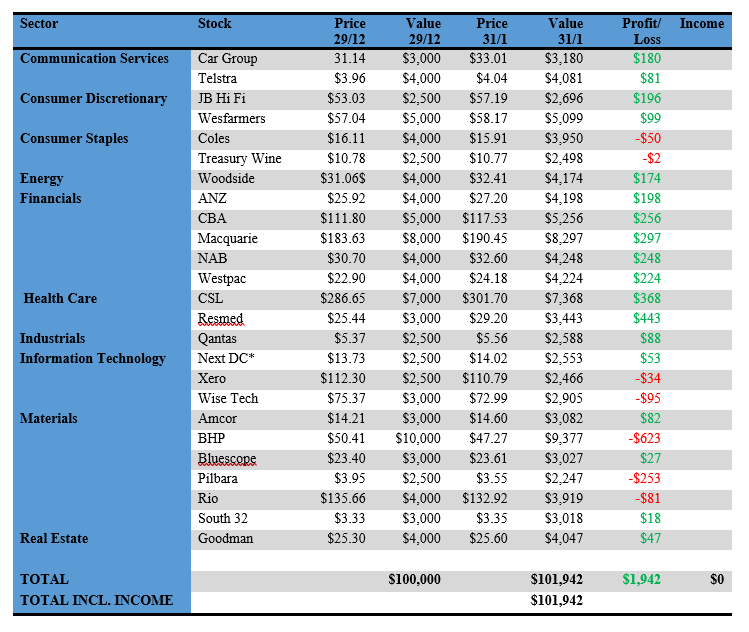At the beginning of the year, we updated our portfolios for 2024. There are two model portfolios – an income oriented portfolio and a growth portfolio. The objectives, methodology, construction rules and underlying economic assumptions can be referenced here: (see:
https://switzerreport.com.au/advice/model-portfolios/ )
These are long-only model portfolios, and as such, they are assumed to be fully invested at all times. They are not “actively managed”, although adjustments are made from time to time.
In this article, we look at how they have performed so far in 2024. To do so, we will start by examining how the overall market has fared.
Large caps and financials lead
The tables below show the performances in January of the components and industry sectors that make up the Australian share market.
Following the trend of 2023, large caps continued to lead. The S&P/ASX 20 index, which represents the largest 20 stocks by market capitalization, rose by 1.5% in the month. Smaller caps (stocks ranked 101st to 300th by market capitalization) recorded a gain of 0.9%, while mid-caps, as measured by the Midcap 50 index which tracks stocks ranked 51st to 100th, went backwards by 2.2%.
Market Component Performance

With the industry sectors, the largest sector by market weight, financials, which makes up 29.4% of the overall S&P/ASX 200 index, was a standout with a gain of 5.0%. Higher oil prices supported the energy sector with a return of 5.2%, while health care also performed strongly adding 4.3%.
On the other side, the second largest sector by market weight, materials, was the major loser giving up 4.8%. Iron ore and lithium miners traded down. Consumer staples was also soft, posting a flat return.
Industry Sector Weighting and Performance

Portfolio performance in 2024
The income portfolio to 31 January has returned 2.19% and the growth oriented portfolio has returned 1.94% (see tables at the end). Compared to the benchmark S&P/ASX 200 Accumulation Index (which adds back income from dividends), the income portfolio has outperformed by 1.00% and the growth portfolio by 0.75%.

Income portfolio
The objective of the income portfolio is to deliver tax advantaged income whilst broadly tracking the S&P/ASX 200.
The income portfolio is forecast to deliver an income return of 4.6% (based on its opening value at the start of the year), franked to 78.2%.
The portfolio is moderately overweight financial stocks and energy and underweight the more growth oriented sectors such as information technology and health care. It is also underweight real estate (incl. property trusts). In a strong bull market, the income portfolio will typically lag the market, and in a bear market, it is likely to outperform.
In the month of January, the income portfolio returned 2.19%, outperforming the benchmark index by 1.00%.
No changes to the portfolio are proposed at this point in time.
The income biased portfolio per $100,000 invested (using prices as at the close of business on 31 January 2024) is as follows:

Growth portfolio
The objective of the growth portfolio is to outperform the S&P/ASX 200 market over the medium term, whilst closely tracking the index.
The portfolio is moderately overweight materials, health care and information technology. It is moderately underweight financials, industrials, real estate, and utilities. Overall, the sector biases are not strong.
In the month of January, the income portfolio returned 1.94%, outperforming the benchmark index by 0.75%.
No changes are proposed to the portfolio at this point in time.
Our growth-oriented portfolio per $100,000 invested (using prices as at the close of business on 31 January 2024) is as follows:

Important: This content has been prepared without taking account of the objectives, financial situation or needs of any particular individual. It does not constitute formal advice. Consider the appropriateness of the information in regards to your circumstances.

